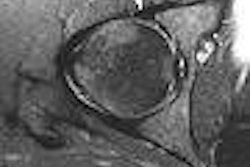Researchers at the International Symposium on Endovascular Therapy (ISET) have backed contrast-enhanced MR angiography (MRA) for diagnosing renal artery stenosis, which they say could be a good alternative to more invasive modalities.
"MRA offers a safe, effective, noninvasive method to screen patients who are suspected of having renal artery stenosis," said Dr. Robert Lookstein during a talk at the 2005 ISET conference in Miami Beach, FL. Lookstein is an assistant professor of radiology at the Mount Sinai School of Medicine in New York City.
He cited a meta-analysis of 25 studies that examined contrast-enhanced and non-contrast enhanced MRA. Those results showed that with non-enhanced MRA, the accessory renal artery was identified 49% of the time. The series of 499 angiographies produced a sensitivity of 94% and a specificity of 85%, Lookstein said.
However, the results improved with gadolinium-enhanced MRA, with the renal arteries identified 82% of the time. Sensitivity increased to 97% and specificity reached 93%(Clinical Radiology, July 2002, Vol. 57:7, pp. 617-24).
Other advantages of contrast-enhanced MRA include low invasiveness; no ionizing radiation; and the lack of nephrotoxicity. Also, MRA allows access to the renal parenchyma. Finally, 3D post-processing is a useful tool, Lookstein said. Some of the disadvantages of MRA include a contraindication for patients with pacemakers, a lower resolution, and the inability to detect calcifications.
Still, for high-risk vascular patients, contrast MRA is the more attractive exam, he said. The less invasive nature of MRA is especially attractive. He said the modality's lack of ionizing radiation makes it a choice for diagnosing younger patients, letting them avoid the potential for downstream radiation-caused disease. "The use of MRA is ideal for patients at the greatest risk," he said.
Advances in the modality will include more information on the response to revascularization, while newer stent designs will allow for the diagnosis of in-stent stenosis, Lookstein added.
By Edward Susman
AuntMinnie.com contributing writer
February 22, 2006
Related Reading
High resolution, fast acquisition give 3D MRA edge in abdomen, January 20, 2006
New Doppler index may be better for diagnosing renal artery stenosis, March 23, 2005
Copyright © 2006 AuntMinnie.com



.fFmgij6Hin.png?auto=compress%2Cformat&fit=crop&h=100&q=70&w=100)




.fFmgij6Hin.png?auto=compress%2Cformat&fit=crop&h=167&q=70&w=250)











